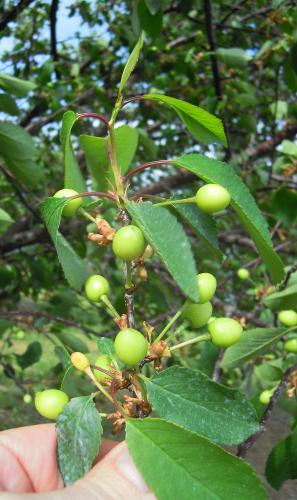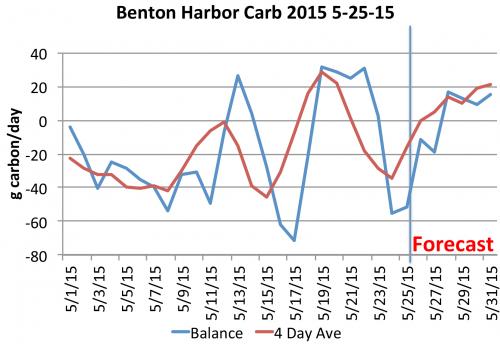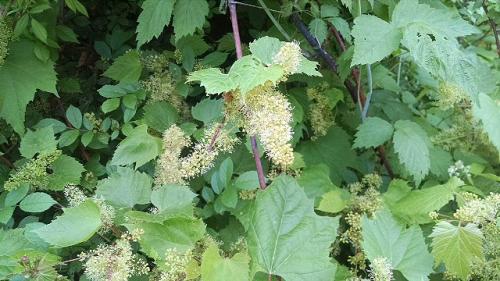Southwest Michigan fruit regional report – May 26, 2015
Warm conditions will move fruit and insects rapidly this week. Blueberries and strawberries are still blooming.

Weather
Last week was unseasonably cool and dry with highs in the 50s and 60s and lows near the 30s and 40s. A frost late Wednesday morning, May 20, caused no damage with temperatures in most areas remaining just above freezing. Warm air moved into the region Friday, May 22, bringing warmer conditions but little rain. High temperatures were in the mid-70s for the weekend. Rainfall totals for the week (Sunday to Sunday) were 0.1 to 0.2 inches of rain. Soils are beginning to dry and soil temperatures are in the 60s. Monday was warm and windy with isolated showers moving across the region. Monday’s rain showers dropped 0.03 to 0.3 inches of rain.
Warmer conditions with continuous spotty showers are predicted for the upcoming week with highs in the 70s and 80s and lows in the 60s. A cold front Friday, May 29, is predicted to bring cooler weather next weekend. Plant development continues to be in spurts during warm periods and slow growth during cool periods. Shoots and fruit should develop rapidly with this warm week.
Southwest Michigan GDD summary from Jan. 1 to May 24, 2015 | |||
|---|---|---|---|
|
Station |
GDD 42 F |
GDD 45 F |
GDD 50 F |
|
Bainbridge/Watervliet |
685 |
547 |
361 |
|
Lawton (Lawton) |
717 |
576 |
389 |
|
Fennville (TNRC) |
577 |
452 |
289 |
|
Average for the region |
695 |
555 |
368 |
Tree fruit
The warm weekend enhanced insect activity. A few plum curculio egglaying scars were found last Monday following a warm weekend. With warmer weather forecasted this week, plum curculio is a threat to young fruit. Tarnished plant bugs are also a threat at this time. Tarnished plant bugs build up on broadleaf weeds and become a threat to growing fruit when the insects move to the trees, especially after the cover crops are mowed.
The largest apricot fruit are over an inch in diameter.
Peaches are out of shuck split and 10 to 13 millimeters in diameter. Foliage at the end of twigs damaged by cold winter temperatures is looking weak on some varieties. Peach leaf curl symptoms are generally mild. Peach leaf curl was not found where preventative treatments were used. Bacterial spot symptoms are generally light. Last year’s problems with this disease on peaches, plums and apricots trace back to a series of wind storms on June 23, 25 and 30. One bacterial spot management strategy to consider is to apply bactericides to borders, especially west sides of orchards with disease-susceptible varieties, before predicted storms.
Oriental fruit moth adults continue to be caught in good numbers, and growers should protect against ongoing egg hatch. Shoot strikes on peaches should appear soon. Plum curculio and tarnished plant bugs can be serious pests when warmer conditions return.
Sweet cherries are 10-12 millimeters in diameter. Some fruit drop is occurring, but crop potential is still good. Plum curculio is a threat when temperatures rise above 75 degrees Fahrenheit after shuck split. Cherry leaves are always susceptible to cherry leaf spot; apply protectant fungicides before rain events. Sweet cherries are susceptible to brown rot at all stages of development.
Tart cherries are 10 millimeters in diameter and the pits are hard. The crop continues to look good, but we have not seen the June drop. Some second and third leaf trees exposed to winter temperature in the minus 20 F or lower range this past winter are showing young limb dieback and decline. Growers need to continue to protect against cherry leaf spot. Growers can use the Michigan State University Enviro-weather forecast model for cherry leaf spot to help guide their sprays and track infection periods. Growers need to be sure they protect new leaves as the season progresses to slow the progression of the disease. Tart cherries are moderately tolerant to copper applications that can help reduce bacterial canker and cherry leaf spot in cherries.

Montmorency cherries have finished fruit drop and all the remaining fruit is about 10 millimeters in diameter. Photo credit: Mark Longstroth, MSU Extension
Japanese plum fruits are 12 to 14 millimeters in diameter. European plums are 8 to 13 millimeters in diameter. Plums are susceptible to bacterial leaf spot. Growers also need to protect against black knot until shoot growth ceases later in the season. Plum curculio egglaying scars can be found in the area – additional damage is a threat during warm, still evenings for a few weeks following shuck split.
Apple fruits are 10 to 19 millimeters in diameter, with varieties in some sites self-thinning. Now is a critically important time to inspect apple orchards. How heavy is the crop? Is there any apple scab or fire blight? What is the insect situation? Yellow-white leaf blotches due to streptomycin treatment are common in apples this year. These are not a significant problem. We are near the end of primary scab with spores mature, but not all discharged. Symptoms of apple scab were reported May 13. These were probably from the April 19 infection period. More scab symptoms from the infection periods on May 5 and May 8 should have appeared now. Growers should scout for scab lesions to assess their control. The next good rain should exhaust the spores, but growers should maintain protection through the week. If no apple scab symptoms are in the orchard, growers can reduce their fungicide applications.
Fire blight symptoms should have appeared over the weekend from infections on May 8. Oozing blossom blight symptoms will increase the bacteria in orchards. With windy, rainy weather forecasted this week, growers should be ready to apply Mycoshield to suppress the disease in blocks with oozing fire blight strikes or cankers. Some apple growers used Apogee at bloom to reduce shoot growth and fire blight spread in young shoots. Apogee will only reduce the spread of fire blight in the tree, not protect the shoot and leaves from trauma blight from hard driving rains or hail.
Codling moth adults were trapped beginning as early as May 8 in some locations. Egg hatch from this early moth flight is underway. Some areas had a later moth flight during the warmer weather May 16. Michigan State University Extension recommends growers use the Enviro-weather codling moth model to time insecticide applications. Plum curculio will be a problem with warmer days and nights this week.
Warm weather predicted this week will be a good apple thinning window. Chemical thinners work well under warm conditions. Many growers applied thinners over the weekend, but conditions were not as warm as predicted. It will take about a week to 10 days for the effects of recent thinners to become apparent. Many apples are growing past the sweet spot for apple thinning when the fruit are about a half-inch in diameter (12-13 millimeters). The Cornell Carbohydrate Model for the Benton Harbor Enviro-weather station predicts low stress (low demand and high supply of carbohydrate) for the week. Growers need to decide now if they need more thinning and apply thinning sprays in the next few days. Because the trees will not be under stress, use higher rates and thin aggressively. Cooler weather is forecasted for the weekend and thinners will be ineffective.

The Cornell Carbohydrate Model for the Southwest Michigan Research and Extension Center in Benton Harbor, Michigan, on May 25, 2015. The model estimates the carbohydrate status of apple trees as affected by current and forecast weather and tree growth stage. Use the four-day average curve to estimate stress and forecast thinning success. The current model forecast is for little stress and positive carbohydrate balance and thinners will be less effective because the tree is less likely to drop fruit.
Pears are 14 to16 millimeters in diameter. Crop potential is generally good. Monitor for pear psylla now. A post-bloom spray during active shoot growth is the preferred control window.
Small fruit
Grapes, after several cold nights last week, have sped up in shoot growth with the warmer weather. Juice grapes are now in the 8- to 18-inch range and flower clusters are elongating and flower clusters are separating in the bunch. In wine grapes, shoots are in the 6- to 12-inch stage. Growers need to focus on early season disease control. At this time, the primary disease is still Phomopsis. Downy mildew is unlikely to occur currently, unless there is warm, heavy rain. Powdery mildew and anthracnose should also be protected against at this time, particularly in vulnerable varieties with a history of infection. Most grape growers will time a final pre-bloom fungicide application for just before bloom and choose their fungicides to include protection against all the major grape diseases. Grape bloom, the most critical period for disease control, is only a week or so away.
Grape berry moths are out. It is too early for treatment. Bloom has begun in wild grape vines in some areas of southern Berrien County. Scout tree lines now to find wild grape and watch for 50 percent bloom. Growers and scouts should record the date of 50 percent wild grape bloom. This date is used in Enviro-weather's grape berry moth model to determine ideal timing of insecticide applications. Leafhoppers will also appear soon. For most vineyards in most years, a spray for these leaf-feeding insects is not needed. In cases of severe infestation, systemic insecticides are effective.

Wild grape in bloom. Grape berry moth biofix is 50 percent of full bloom. Photo credit: Keith Mason, MSU
Blueberry bloom continues. The cold weather last week caused reddening of the leaves; this will go away when warmer temperatures return. Early blooming varieties have finished bloom, but later blooming varieties are in early petal fall. At petal fall, the focus of protection shifts to protecting the fruit and shoots from anthracnose and phomopsis. Cherry fruitworms have been flying for about a week and will begin laying eggs on green fruit soon. Cranberry fruitworms should be out as well with the warmer temperatures. Avoid spraying during the midday; apply sprays at night or during the early morning or evening hours when bees are not active.
Strawberry bloom is ending and there are thimble-sized fruit in many fields. With wet conditions, growers need to protect open blossoms, fruit and leaves. There are many fungicide materials to choose from and Merivon and material similar to Pristine are also labeled on strawberries. See “Merivon, a new fungicide option for disease control in strawberries” for more information. Strawberry harvest may begin in southern Berrien County or in high tunnels this week.
Bramble shoots are 8 to 12 inches long and flower buds are separating in the clusters. Black raspberries have begun to bloom and summer red raspberries will be close behind. Primocanes are showing good growth with warmer soil temperatures. Apply a fungicide to reduce foliar and cane diseases before bloom begins. Scout black raspberries and blackberries for signs of orange rust and remove infected plants.
Upcoming meetings
Our next Monday fruit IPM meeting is June 1 at Fruit Acres Farms, 3452 Friday Rd, Coloma, MI 49038 at 5 p.m. Two Michigan pesticide applicator recertification credits will be given for these meetings.
See also
- Fungicide resistance management considerations for cherry leaf spot control
- Scouting for blossom blight symptoms of fire blight in apples
- How to use Enviro-weather’s apple scab tool
- Codling moths: Thinking about Enviro-weather model and hot and cold temperatures
- First generation codling moth management
- Protect young grape clusters from all major grape diseases
- Protect against blossom blights in blueberries
- What fungicide do I choose for disease control in strawberries?
- Merivon, a new fungicide option for disease control in strawberries



 Print
Print Email
Email




